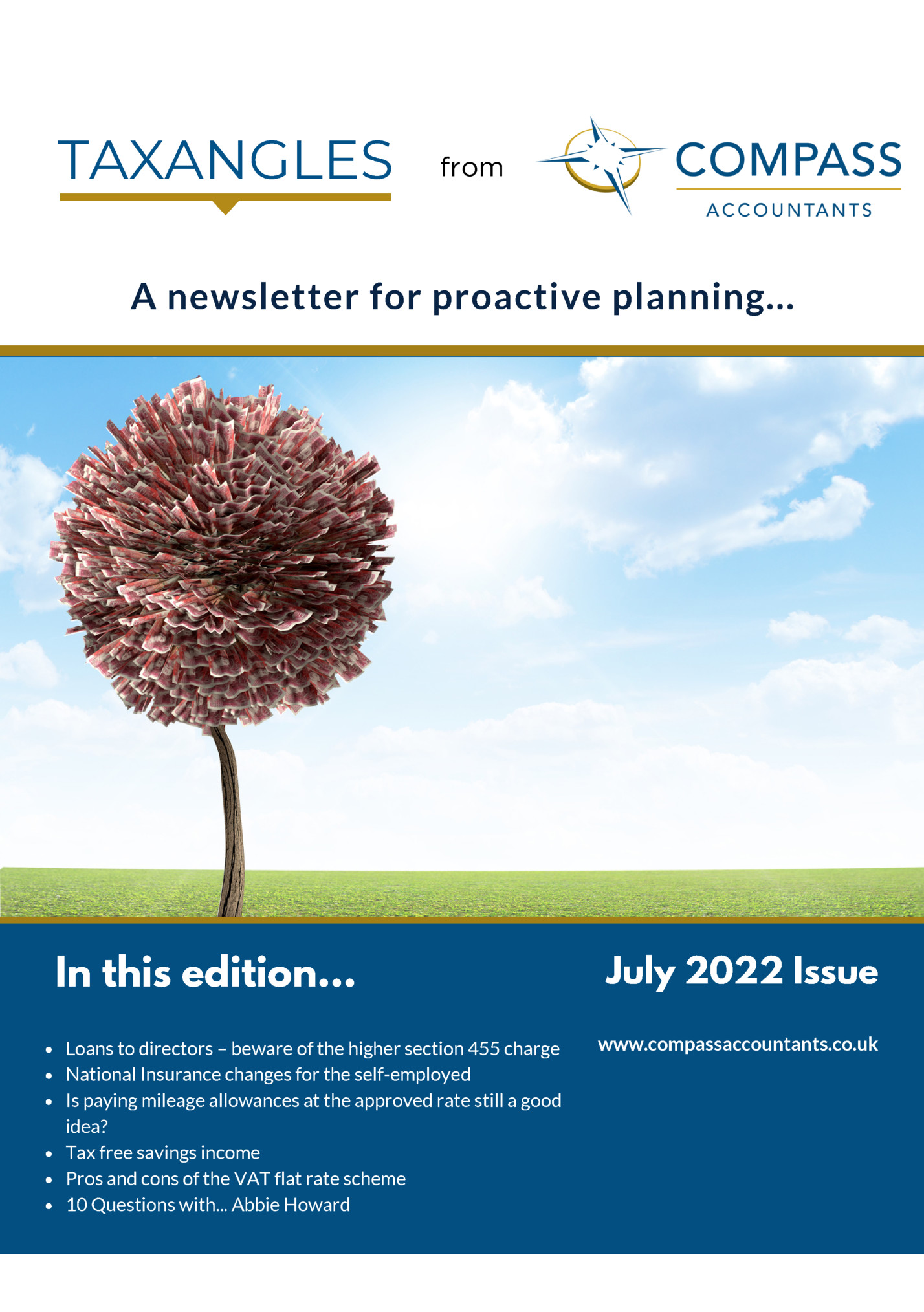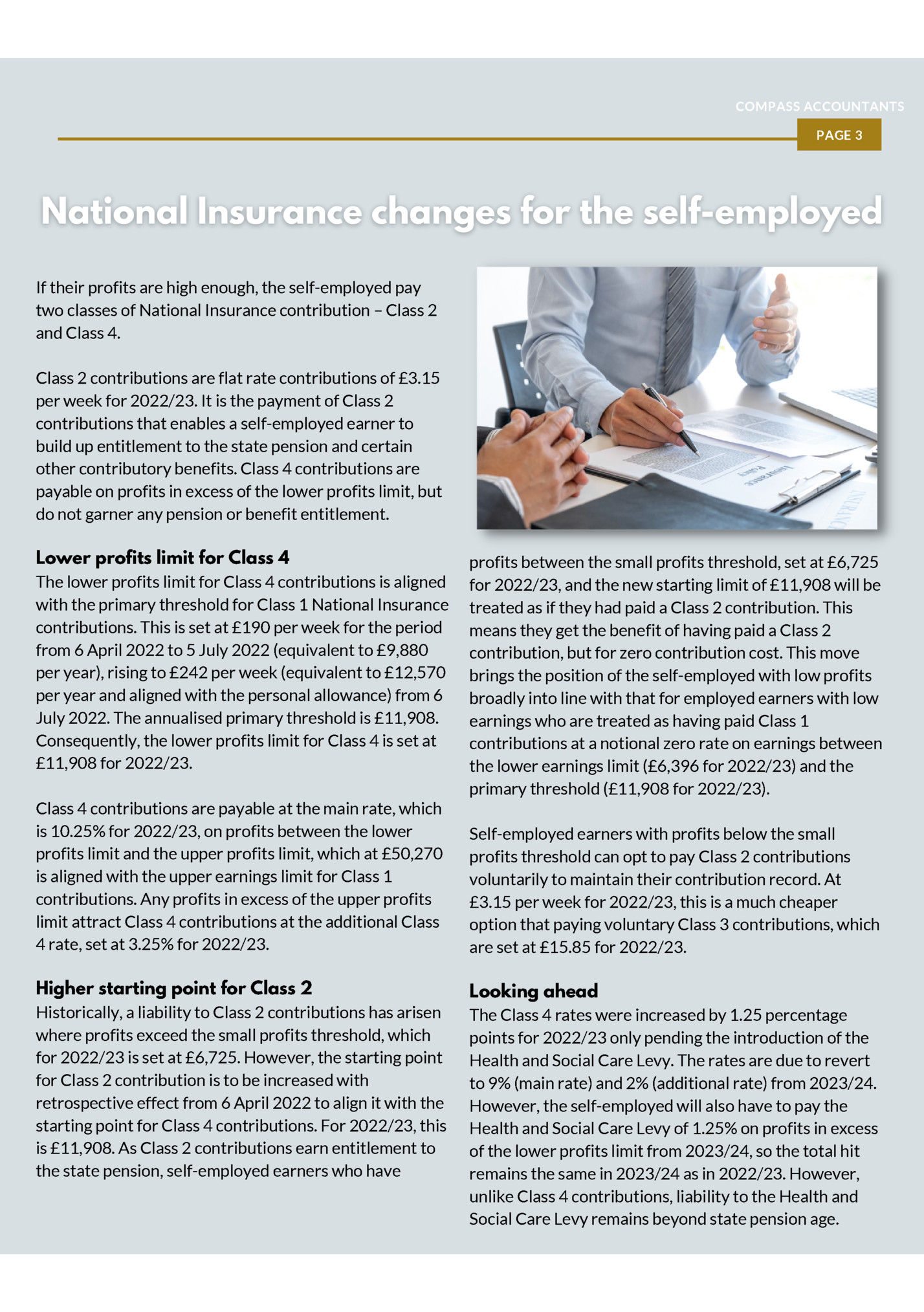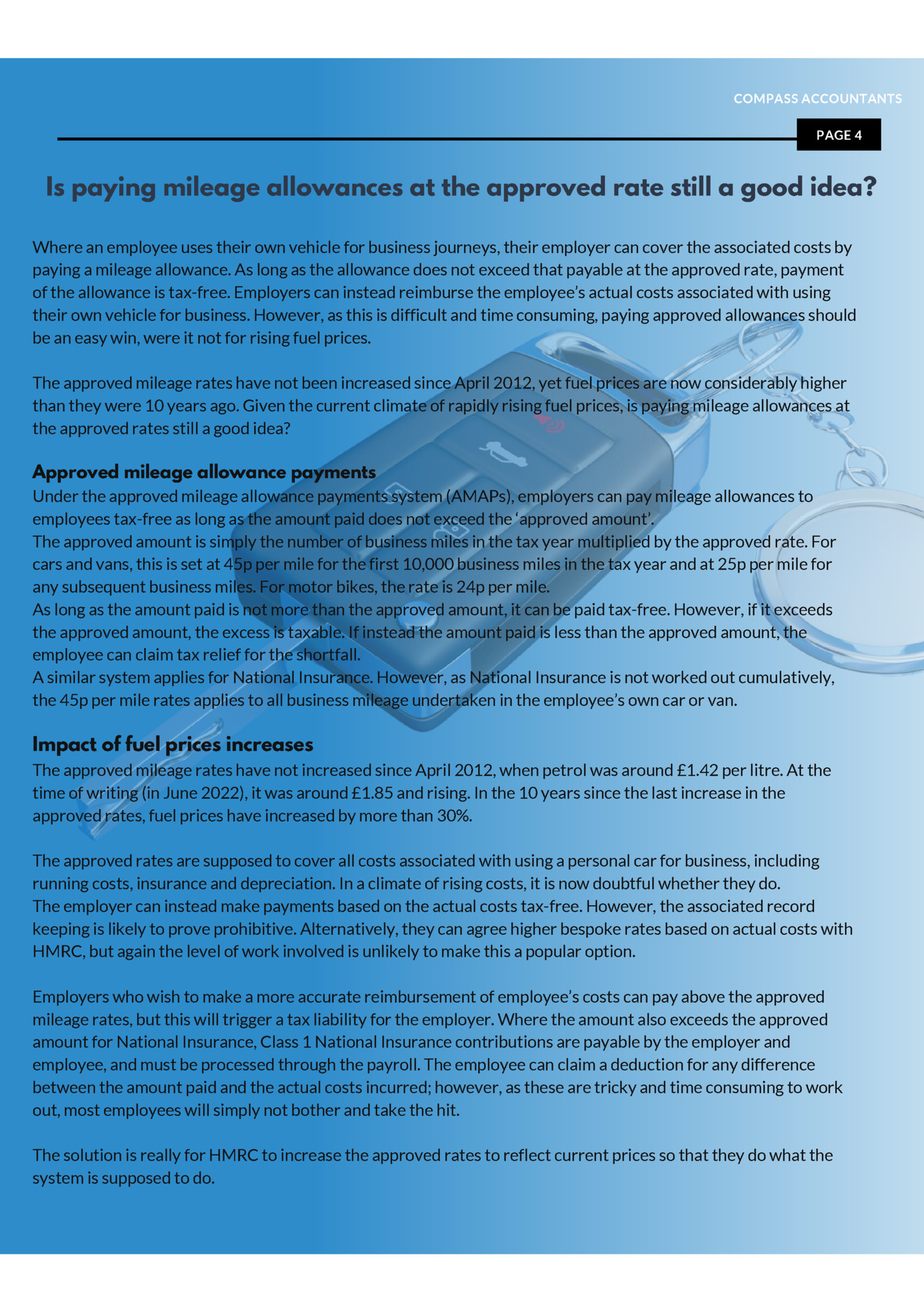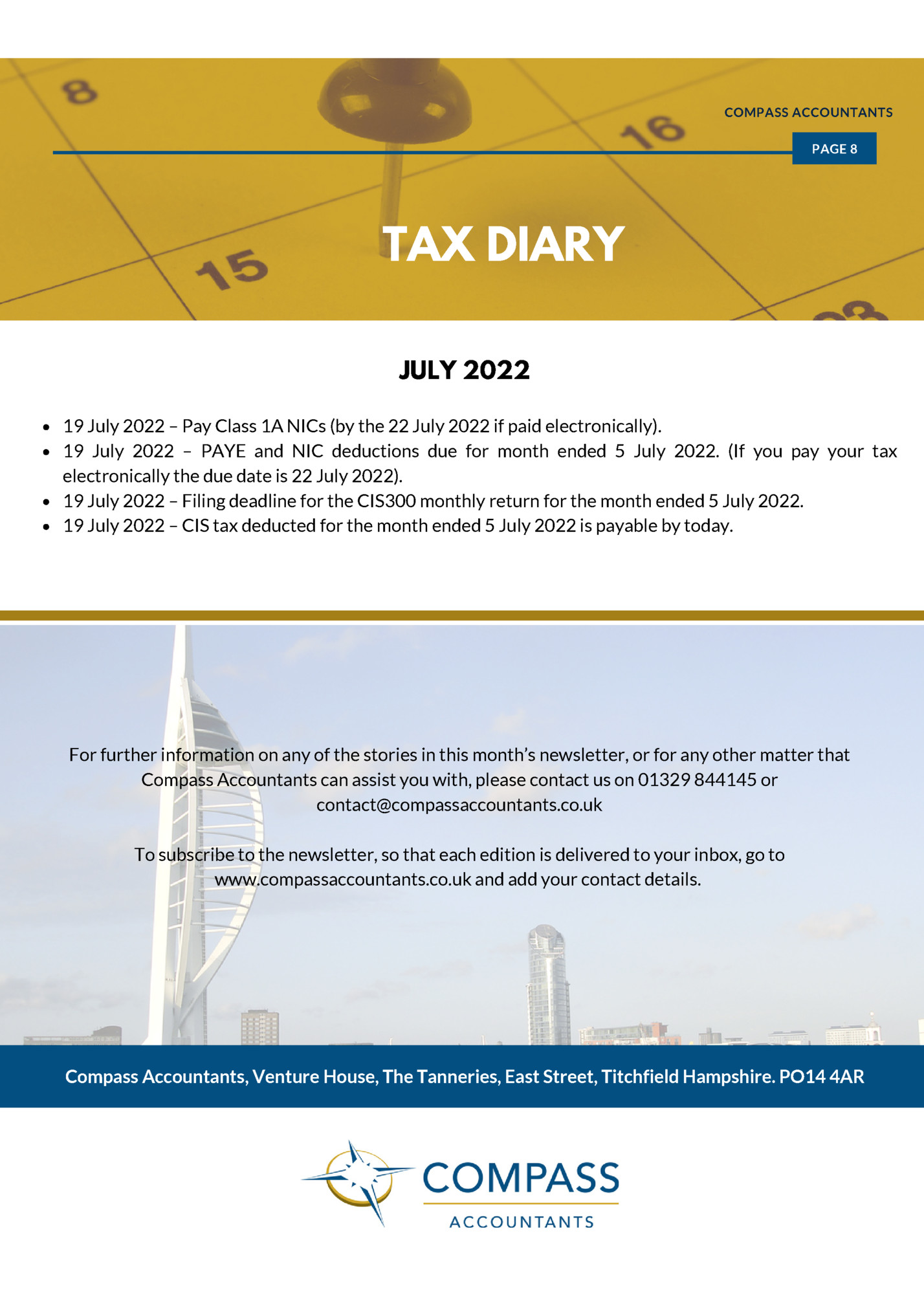from A newsletter for proactive planning... In this edition... July 2022 Issue Loans to directors – beware of the higher section 455 charge National Insurance changes for the self-employed Is paying mileage allowances at the approved rate still a good idea? Tax free savings income Pros and cons of the VAT flat rate scheme 10 Questions with... Abbie Howard www.compassaccountants.co.uk

PAGE 4 2 Loans to directors – beware of the higher section 455 charge Loan remains outstanding Directors and shareholders in close companies are often able to influence the payments that are made to them. Broadly, a close company is one that is controlled by five or fewer shareholders. Personal companies and most family companies are close. In a close company, there are often numerous transactions between the director and the company – the company may, for example, make payments to the director, loan money to the director and may also make payments on the director’s behalf. On the other side of the coin, the director may loan money to the company, repay loans or make payments on the company’s behalf. The director’s loan account provides the means for keeping track of the transactions between the director and the company. However, tax consequences arise if the director’s loan account is overdrawn at the end of the accounting period or if a loan has been made which has not been repaid. Loan repaid by corporation tax due date The corporation tax for an accounting period is due for payment nine months and one day after the end of the accounting period. If the loan is repaid in this period (or the overdrawn balance cleared), there are no further tax consequences. However, the loan must be reported on the company’s corporation tax return. Depending on the amount of the loan, there may also be a benefit in kind tax charge for the director, and a Class 1A National Insurance liability on the company. This will be the case if the amount owed by the director to the company exceeds £10,000 at any point in the tax year. An overdrawn account can be cleared in various ways, for example, by paying money into the company from personal resources, crediting a bonus or salary payment to the account or by declaring a dividend. It should be borne in mind that there will be tax and National Insurance contributions to pay on a salary or bonus payment and tax to pay on a dividend. If the loan has not been repaid and the director’s account remains overdrawn at the corporation tax due date, the company must pay tax on the overdrawn balance. This rate of this tax (Section 455 tax) is linked to the dividend upper rate. Consequently, it was increased to 33.75% from 6 April 2022 in line with the increase in the dividend upper rate applicable from the same date. The increase in the rate means that it is now more expensive for a company to loan money to a director. The rate of Section 455 tax was 32.5% prior to 6 April 2022 (and 25% prior to 6 April 2016). Where a Section 455 tax charge arises it must be paid with the corporation tax for the accounting period, nine months and one day after the end of the accounting period. Crucially, it is not corporation tax, and also unlike corporation tax it is a temporary tax that is repaid if the loan balance is cleared. The tax becomes repayable nine months and one day after the end of the accounting period in which the loan is repaid. It is usually set against the corporation tax for the period, or repaid to the company if there is no corporation tax to pay. The repayment of the section 455 tax must be claimed – it is not made automatically. Planning considerations Personal and family companies will need to budget for the higher Section 455 charge when making loans to directors (or to other participators) that will not be repaid by the corporation tax due date. When deciding whether to clear the loan, the whole picture needs to be considered. It is only worth paying a dividend or bonus to clear the loan if the tax consequences of doing so are less than paying the section 455 tax, for example, if a dividend would be sheltered by the dividend allowance or taxable at the dividend lower rate. Otherwise, it is better to leave the loan outstanding and pay the tax. If the director has several loans made over different period, it makes sense to clear those made on or after 6 April 2022 first.

PAGE 4 3 If their profits are high enough, the self-employed pay two classes of National Insurance contribution – Class 2 and Class 4. Class 2 contributions are flat rate contributions of £3.15 per week for 2022/23. It is the payment of Class 2 contributions that enables a self-employed earner to build up entitlement to the state pension and certain other contributory benefits. Class 4 contributions are payable on profits in excess of the lower profits limit, but do not garner any pension or benefit entitlement. Lower profits limit for Class 4 The lower profits limit for Class 4 contributions is aligned with the primary threshold for Class 1 National Insurance contributions. This is set at £190 per week for the period from 6 April 2022 to 5 July 2022 (equivalent to £9,880 per year), rising to £242 per week (equivalent to £12,570 per year and aligned with the personal allowance) from 6 July 2022. The annualised primary threshold is £11,908. Consequently, the lower profits limit for Class 4 is set at £11,908 for 2022/23. Class 4 contributions are payable at the main rate, which is 10.25% for 2022/23, on profits between the lower profits limit and the upper profits limit, which at £50,270 is aligned with the upper earnings limit for Class 1 contributions. Any profits in excess of the upper profits limit attract Class 4 contributions at the additional Class 4 rate, set at 3.25% for 2022/23. Higher starting point for Class 2 Historically, a liability to Class 2 contributions has arisen where profits exceed the small profits threshold, which for 2022/23 is set at £6,725. However, the starting point for Class 2 contribution is to be increased with retrospective effect from 6 April 2022 to align it with the starting point for Class 4 contributions. For 2022/23, this is £11,908. As Class 2 contributions earn entitlement to the state pension, self-employed earners who have profits between the small profits threshold, set at £6,725 for 2022/23, and the new starting limit of £11,908 will be treated as if they had paid a Class 2 contribution. This means they get the benefit of having paid a Class 2 contribution, but for zero contribution cost. This move brings the position of the self-employed with low profits broadly into line with that for employed earners with low earnings who are treated as having paid Class 1 contributions at a notional zero rate on earnings between the lower earnings limit (£6,396 for 2022/23) and the primary threshold (£11,908 for 2022/23). Self-employed earners with profits below the small profits threshold can opt to pay Class 2 contributions voluntarily to maintain their contribution record. At £3.15 per week for 2022/23, this is a much cheaper option that paying voluntary Class 3 contributions, which are set at £15.85 for 2022/23. Looking ahead The Class 4 rates were increased by 1.25 percentage points for 2022/23 only pending the introduction of the Health and Social Care Levy. The rates are due to revert to 9% (main rate) and 2% (additional rate) from 2023/24. However, the self-employed will also have to pay the Health and Social Care Levy of 1.25% on profits in excess of the lower profits limit from 2023/24, so the total hit remains the same in 2023/24 as in 2022/23. However, unlike Class 4 contributions, liability to the Health and Social Care Levy remains beyond state pension age.

PAGE 4 Is paying mileage allowances at the approved rate still a good idea? Where an employee uses their own vehicle for business journeys, their employer can cover the associated costs by paying a mileage allowance. As long as the allowance does not exceed that payable at the approved rate, payment of the allowance is tax-free. Employers can instead reimburse the employee’s actual costs associated with using their own vehicle for business. However, as this is difficult and time consuming, paying approved allowances should be an easy win, were it not for rising fuel prices. The approved mileage rates have not been increased since April 2012, yet fuel prices are now considerably higher than they were 10 years ago. Given the current climate of rapidly rising fuel prices, is paying mileage allowances at the approved rates still a good idea? Approved mileage allowance payments Under the approved mileage allowance payments system (AMAPs), employers can pay mileage allowances to employees tax-free as long as the amount paid does not exceed the ‘approved amount’. The approved amount is simply the number of business miles in the tax year multiplied by the approved rate. For cars and vans, this is set at 45p per mile for the first 10,000 business miles in the tax year and at 25p per mile for any subsequent business miles. For motor bikes, the rate is 24p per mile. As long as the amount paid is not more than the approved amount, it can be paid tax-free. However, if it exceeds the approved amount, the excess is taxable. If instead the amount paid is less than the approved amount, the employee can claim tax relief for the shortfall. A similar system applies for National Insurance. However, as National Insurance is not worked out cumulatively, the 45p per mile rates applies to all business mileage undertaken in the employee’s own car or van. Impact of fuel prices increases The approved mileage rates have not increased since April 2012, when petrol was around £1.42 per litre. At the time of writing (in June 2022), it was around £1.85 and rising. In the 10 years since the last increase in the approved rates, fuel prices have increased by more than 30%. The approved rates are supposed to cover all costs associated with using a personal car for business, including running costs, insurance and depreciation. In a climate of rising costs, it is now doubtful whether they do. The employer can instead make payments based on the actual costs tax-free. However, the associated record keeping is likely to prove prohibitive. Alternatively, they can agree higher bespoke rates based on actual costs with HMRC, but again the level of work involved is unlikely to make this a popular option. Employers who wish to make a more accurate reimbursement of employee’s costs can pay above the approved mileage rates, but this will trigger a tax liability for the employer. Where the amount also exceeds the approved amount for National Insurance, Class 1 National Insurance contributions are payable by the employer and employee, and must be processed through the payroll. The employee can claim a deduction for any difference between the amount paid and the actual costs incurred; however, as these are tricky and time consuming to work out, most employees will simply not bother and take the hit. The solution is really for HMRC to increase the approved rates to reflect current prices so that they do what the system is supposed to do.

PAGE 5 Tax free savings income There are various ways to enjoy savings income tax-free. However, not all routes are open to all taxpayers – the options depend on the nature of the savings and the saver’s other earnings and marginal rate of tax. Savings Allowance Basic and higher rate taxpayers are entitled to a savings allowance. The allowance is set at £1,000 for basic rate taxpayers and at £500 for higher rate taxpayers. The allowance is available in addition to the personal allowance and also the dividend allowance. Taxpayers who pay tax at the additional rate (which applies to taxable income in excess of £150,000) do not benefit from a personal savings allowance and must pay tax on any savings income unless it is otherwise exempt. There is no need for a separate savings allowance for savers whose total income is less than their personal allowance as the personal allowance will shelter any savings income. Savings starting rate Savings income which falls within the savings starting rate band is taxed at the savings starting rate of 0%. Depending on the individual’s personal circumstances, they may be able to enjoy up to £5,000 of savings income tax-free. The savings starting rate band is set at £5,000, but is reduced by any taxable non-savings income. This is other taxable income in excess of the personal allowance (but excluding any dividends which are treated as the top slice of income). Consequently, the full £5,000 savings starting rate band is available where other taxable income is less than the individual’s personal allowance. The standard personal allowance is £12,570 for 2022/23. The savings starting rate is eroded once taxable income in excess of the personal allowance reaches £5,000. The savings starting rate is applied before the personal savings allowance. Tax-free savings If savings are held within a tax-free wrapper such as an Individual Savings Account, the associated savings income is tax-free. Case study Marion has a state pension of £11,000 a year. She has considerable savings which generate interest of £9,000 a year. She also receives interest of £200 a year from savings held in an ISA. As her total income of £11,000 is less than her personal allowance of £12,570, the remainder of her personal allowance is available to shelter the first £1,570 of her savings allowance. Her pension (her only other taxable income) does not exceed her personal allowance; consequently, she is entitled to the full £5,000 savings starting rate band. Savings falling within this band are tax-free (attracting the savings starting rate of 0%). She is also able to benefit from the personal savings allowance, which is £1,000 because she is a basic rate taxpayer. The remaining interest (other than that from her ISA) of £1,430 (£9,000 - £1,570 - £5,000 - £1,000) is taxed at the basic rate of 20%. The interest of £200 from her ISA is tax-free.

PAGE 6 Pros and cons of the VAT flat rate scheme The flat rate scheme offers VAT registered traders who the margin allowed by the flat rate percentage. meet the eligibility conditions a simpler way to work out the VAT that they need to pay over to HMRC. However, while it may save work, it may also cost more than working out VAT in the traditional way. Nature of the scheme Under the scheme, traders pay a percentage of their VATinclusive turnover over to HMRC, rather than working out the difference between their output VAT and their input VAT. The percentage that they pay is set by HMRC and depends on the business sector in which they operate. Eligibility The scheme is only open to VAT-registered businesses which expect their annual VAT taxable turnover to be £150,000 or less. This is the total of everything that they sell that is not exempt from VAT, and is exclusive of VAT. A trader cannot re-join the scheme if they have left it in the previous 12 months. Once in the scheme, a trader can remain unless their turnover in the last 12 months was more than £230,000 including VAT, or they expect their turnover in the next 30 days alone to be more than £230,000 (including VAT). If this is the case, the trader must leave the flat rate scheme and work out VAT due to HMRC in the usual way. Advantages The main advantage of the scheme is that it is simple and that it saves work. There is no need to keep detailed records, particularly of VAT on purchases and expenses. The VAT that is paid over to HMRC is simply the flat rate percentage multiplied by the VAT-inclusive turnover in the period. The scheme may also save money if the VAT due at the flat rate is less than that using the traditional calculation. Disadvantages The main disadvantage is that more VAT may be payable to HMRC than if VAT is calculated in the traditional way. This will be the case if the amount determined using the flat rate percentage is more than the difference between output VAT and input VAT in the period. Much will depend on whether the traders input VAT is covered by The scheme can be particularly costly for limited cost businesses. These are business where goods are less than either 2% of turnover or £1,000 a year (£250 per quarter). Limited cost businesses must use a higher rate of 16.5% to work out the VAT that they pay over to HMRC, regardless of the sector in which they operate. The rules can operate harshly for limited cost businesses. In deciding whether a business is a limited cost business, no account is taken of spending on services on which VAT is incurred. The flat rate percentage for limited cost businesses of 16.5% of VAT-inclusive turnover is equivalent to 19.8% of net turnover, leaving little margin for input VAT recovery as 99% of the VAT charged at 20% must be paid over to HMRC. This may be problematic for a business that spends little on goods but which incurs significant VAT on services and items such as fuel and promotional items, which are excluded from the calculation. Where this is the case, the trader may pay much more VAT over to HMRC than under traditional VAT accounting. Do the sums In order to decide whether the time savings offered by the VAT Flat Rate Scheme are worthwhile, there is no substitute for doing the sums.

PAGE 7 10 Questions with ... Abbie Abbie Howard has joined the Compass Accountants team as an Accounts Senior- Here we ask 10 Questions about herself... her 1.What is the first thing you would buy if you won the lottery? A holiday, followed by a car, followed by a house. 2.How did you get into accounting? I loved maths growing up so chose accounting as one of my A-Levels and loved it. 3.What is your favourite film? Dirty Dancing 4.What was your first ever job? Sales assistant at NEXT 5.If you could invite anyone (dead or alive) to your dinner party who would you invite? Patrick Swayze, see question 3. 6.What do you like most about working for Compass Accountants? The team, there is a very friendly welcoming atmosphere in the office! 7.Which super power would you most like to have and why? To stay young forever and be able to teleport. 8.What is your favourite place in the world that you have been? New York City 9.What did you want to be when you were growing up? Air Hostess 10.Tell us one strange or unique fact about yourself! I am incredibly clumsy and often referred to as Bridget Jones by friends and family. CONTINUED ON PAGE 9

PAGE 8 TAX DIARY JULY 2022 19 July 2022 – Pay Class 1A NICs (by the 22 July 2022 if paid electronically). 19 July 2022 – PAYE and NIC deductions due for month ended 5 July 2022. (If you pay your tax electronically the due date is 22 July 2022). 19 July 2022 – Filing deadline for the CIS300 monthly return for the month ended 5 July 2022. 19 July 2022 – CIS tax deducted for the month ended 5 July 2022 is payable by today. For further information on any of the stories in this month’s newsletter, or for any other matter that Compass Accountants can assist you with, please contact us on 01329 844145 or contact@compassaccountants.co.uk To subscribe to the newsletter, so that each edition is delivered to your inbox, go to www.compassaccountants.co.uk and add your contact details. Compass Accountants, Venture House, The Tanneries, East Street, Titchfield Hampshire. PO14 4AR

Fleepit Digital © 2021